



Preston Plantation in Trimble County
Nonprofit
group hopes
to create living history attraction
Venards want site used for education, period events
By
Helen E. McKinney
Contributing Writer
BEDFORD, Ky. (June 2006) – Many refer to them
as the “Ghost Roads.” These are 25 miles of roads used by
slaves in the 19th century to navigate around Preston Plantation’s
original 1902 borders. And if you’re really quiet on a mid-summer’s
evening, you might just feel their presence in the air and see their
spirits return to navigate travelers through the farm.
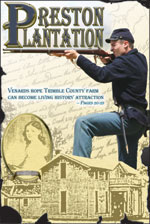 |
|
June
2006 Indiana & |
You might feel the vibrations of their feet pounding the
dusty dirt road, or hear their voices as they pass along coded messages
for slaves who have stopped at the plantation on their way north to
freedom. The plantation has been included as part of the 100-mile “Freedom
Corridor” mapped out by the organizers of the National Underground
Railroad Freedom Center, the Cincinnati riverfront museum that opened
in 2002.
This is just part of the history that Pam and Paul Venard hope to share
with others. The couple owns two lots – about 160 acres –
of Trimble County’s original 7,945-acre Preston Plantation. For
several years, they have held Civil War re-enactment events in the hope
of educating the public about life along the Ohio River at Preston Plantation
during that era. This is just one example of the type of living history
event the Venards want to portray.
On June 3-4, for instance, the Venards will play host to “Ghost
Roads Homecoming” in an attempt to raise visibility for Preston
Plantation. Re-enactors will converge upon the area, bringing to life
its rich history of the Ohio River, Underground Railroad activity and
the life of Henry Bibb, a Trimble County slave who escaped to Canada
and continued his efforts as an abolitionist and the first black newspaper
editor there.
This event is open to the public and lasts from 10 a.m. to 3 p.m. both
days. Author Hugh Ridenour, a Kentucky Heritage Council speaker, is
scheduled to speak at 1 p.m. Saturday on “A Surgeon’s Life
in the Orphan Brigade.” The Orphan Brigade was a Confederate unit
of soldiers not recognized by their home states, which remained in the
Union. Mary Howard Wickliffe Preston’s brother-in-law and first
cousin was a general in the Orphan’s Brigade.
Ridenour will be followed by a Civil War “skirmish” re-enactment
event at 2 p.m. Also planned are hayrides and a medicine show.
Last year’s Civil War Re-enactment event attracted 200 people,
said Pam Venard, 58. A second re-enactment weekend is held each year
during the first weekend of October. “Education is what we’re
trying to do,” she said.
The Venards have held these type of events for six years
and believe they have done as much as they can on their own. But they
want to do more. Now they feel that it is time for others to help run
Preston Plantation. To achieve their goal of preserving the area as
a sort of living history museum, they are seeking help from other like-minded
individuals, educational organizations, civic groups or even corporate
sponsors.
Over the past few months, the Venards recruited a board of directors
for Preston Plantation Inc. that includes Trimble County Judge-Executive
Randy Stevens, Ken Knouf, resource manager at Jefferson Proving Ground
in Madison, Ind.; Karl Lietzenmayer, editor of the Northern Kentucky
Heritage magazine; Darren Pike, editor of the Trimble Banner-Democrat;
two of the Venards’ three daughters, Rebecca Venard and Mariah
Shadoan; and Mariah’s husband, Kyle Shadoan. The board also includes
Tom Crutcher, general manager of Trimble County’s LG&E power
station, which sits adjacent to the plantation; Ted Farrell, a professor
at Hanover College; and John Dunlap of the Bedford Loan & Deposit
Bank. The board immediately set to work on developing a business plan
to create a unique tourist attraction for Trimble County. Venard labeled
it a “work in progress.”
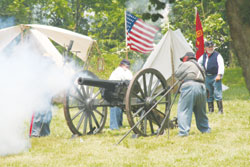 |
|
Photo
by Don Ward Civil
War re-enactors fire a cannon |
Preston Plantation, Inc. gained non-profit status in 1991.
It will take much work for interested people to establish the site and
recreate a bygone era, she said. To help with the project, the group
hired two consultants – Christina D. Hansen and Alicia Johnson,
two University of Louisville MBA graduates – to draft a master
plan. After learning they were both graduating from an entrepreneurial
program, the Venards contacted them to help develop more concrete plans
for the future of Preston Plantation, said Hansen.
The two began working on the master plan a year ago. It includes many
phases stretched over a 15-year period. In addition to a living history
museum, an emphasis is being placed on “working with the artists’
community in Madison,” said Hansen. The board of directors hope
to see local artists attracted to the site who would promote it through
the selling of their artwork during re-enactments and in a future gift
shop.
Today, the Preston’s 1852-53 farm house still stands on the farm’s
western high ground. For the last 20 years, it has been tended to by
R.L. and Cleo Devine, who rent and live there. For many years, the 455-acre
farm was owned by the late Gayle Rodgers. It is now owned by Trimble
County farmer Darrell Wheeler, but Wheeler in May negotiated the sale
of the farm to two Louisville men, Mark Timmons and Garland Lewis. They
take over the property June 15 and have told the Devines they could
stay in the house until the end of the year. It is uncertain what plans
the new owners have for the Preston home place or adjacent outbuildings.
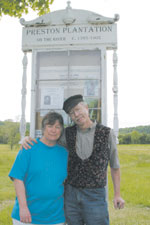 |
|
Photo
by Don Ward Pam
and Paul Venard |
The men also have negotiated the purchase of the adjacent
Raymond Conrad property and are close to negotiating the purchase of
the adjacent Robert Collins property. Those two additional parcels total
about 150 acres and were part of the original Preston Plantation. All
three parcels are located on the western high ground overlooking the
167 acres along the Ohio River that the Venards’ own.
The Venards inherited the land upon the death in 1987 of Virginia Venard,
Paul’s mother, who willed that land to Paul and his two sisters,
Pamela Yeckel and Gayl Ponce. After a protracted legal dispute, Paul
in 1991 bought out his sisters’ share of the land.
The sisters had wanted to sell their share of land to Collins after
they had signed a contract to sell it to Paul. Collins subsequently
sued the Venards but lost the lawsuit in 2003. Collins died last year.
Conrad also is deceased.
The Venards hope the nonprofit group can eventually gain access or ownership
of the Preston farm house on the hill, where they envision establishing
a museum. That will depend on what the new owners decide.
Another antebellum two-story farm house that the Venards in 1975 paid
to have moved from the LG&E power plant site onto the Venards' farm
is being targeted for a possible inn, restaurant and gift shop. The
house was moved to avoid demolition when the power plant was built.
The Venards consider the house significant because it is tied to a former
Trimble County resident, Frank Lee, a staunch Lincoln Republican who
moved there in 1856 and may have been involved with the Underground
Railroad. Lee called the house Freedom Home, a possible reference to
activities that occurred there. The Venards hope to someday use the
house for staging seasonal activities, such as Ghost Road tours, hayrides,
hiking, camping and activities geared toward archaeology.
The Venards say formal planning sessions conducted by the new board
of directors and its consultants will hopefully encourage financial
investors to support these projects. Through preservation, renovation
and rebuilding projects, the couple hopes to restore a disregarded piece
of local history.
The Venards placed their farm under a conservation easement with Purchase
Agricultural Conservation Easement Corp., which guarantees that their
property will always be protected from modern development.
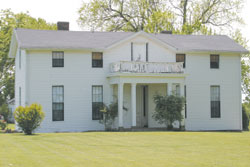 |
|
Photo
by Don Ward John
and Mary Preston’s former |
“The south end of Harlan Hubbard’s land is somewhat
protected, too,” said Pam Venard. Hubbard, who died in 1988, was
a well-known author and painter whose former home, which he dubbed “Payne
Hollow,” lies near the plantation. The close proximity of Payne
Hollow adds to the history of the farm, Pam Venard said.
After researching and considering area demographics and other area attractions,
Hansen and Johnson suggested several other scenarios for board to consider.
Their strategic planning process looked for ways to add to the attraction
and educational mission of the nonprofit organization.
In addition to focusing on area artists and craftspeople, they suggested
that a conference center be established to host various events. A U-pick
farm would be a way to offer fresh produce from local farmers, and a
petting zoo would be a draw for tourists with young children.
The board of directors is working with other Underground Railroad entities
to accomplish their goals, said Venard. The recently opened National
Freedom Center in Cincinnati, the Henry Bibb National Trail Project
and the Historic Eleutherian College in Lancaster, Ind., are considering
partnering on some level with Preston Plantation Inc., the Venards say.
Louisville-based researcher Diane Perrine Coon is spearheading the Henry
Bibb National Park Service Trail project, which is an effort to document
and interpret Bibb’s Civil War era activities while he was in Trimble
County. The project is being directed by Oldham County Historical Society
and supported by a $5,000 Kentucky Heritage Council grant. The project’s
goal is to develop an educational program about Bibb.
Asked about the significance of Preston Plantation, Coon recommended
that the Venards piggyback on the Bibb project. The Venards have documented
evidence of one Preston Plantation slave, Alfred, who escaped to Winsor,
Canada. “They have enough pieces to put together a story relating
to Underground Railroad activity,” Coon said.
“I love anything that would preserve as much as possible and give
an insight into what was there. As a historian, I always look toward
those who try to preserve some aspect of history.”
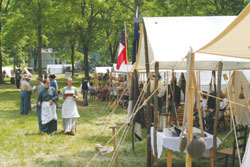 |
|
Photo
by Don Ward Re-enactors
spend the weekend |
On a plantation with more than 60 slaves and only
one manager and overseer, “it makes sense that there was at least
some activity in the Underground Railroad,” Coon continued. There
were many limestone caves and places to hide on the plantation and across
the river in Indiana.
The Venards have searched for clues about families on the Indiana side
of the river who might have acted as “catchers” of fleeing
slaves. Lee Bottom near Saluda Township lies directly across from the
former plantation.
The Venards plan to have a replica of the “Trimble” paddlewheel
ferryboat, circa 1895, to be constructed as part of their project.
They have already received bids from at least two companies. Once complete,
river excursions would be available for those researching the Underground
Railroad and for use by the Rivers Institute at Hanover College.
The Rivers Institute is an educational resource dedicated to learning
about aspects of river systems using the liberal arts. It was established
in 2004 by an $11 million Lilly Endowment grant.
Last year, the Rivers Institute helped organize a daylong educational
program in conjunction with Preston Plantation in which several students
from Northern Kentucky University participated. In May 2005, a customized
barge crossed the Ohio River beginning at Preston Plantation and bringing
passengers across the river to Indiana. From there, they trekked up
the hill for lunch and a seminar at Hanover College.
After this trial run, there had been talk of continuing such a crossing
to educate passengers about the area’s history, said Michelle Gammon
Purvis, program coordinator for the Rivers Institute. But Purvis said
she does not know if the Rivers Institute would be “the organizing
principle. We’re not planning to continue the event at the moment.”
Paul Venard, 62, a farmer and sculptor, has drawn up sketches that naval
architects in Gulf Breeze, Fla., and Sturgeon Bay, Wisc., are reviewing.
Such a boat would be “like a bridge” said Paul Venard. “It
would serve both sides of the river.” He predicts that such a boat
would increase tourism for Indiana and Kentucky.
Any time tourism is created, it is great for the county, said Stevens,
the county judge and a Preston Plantation board member.
“Tourism helps preserve the heritage of the county. It puts a title
on a place that not a lot of people may be familiar with,” said
Stevens.
The board may have what Stevens termed “very lofty goals”
and will have to create a way to generate public interest in this project.
Big numbers are still on the budget sheet to make the Venards’
plans a reality.